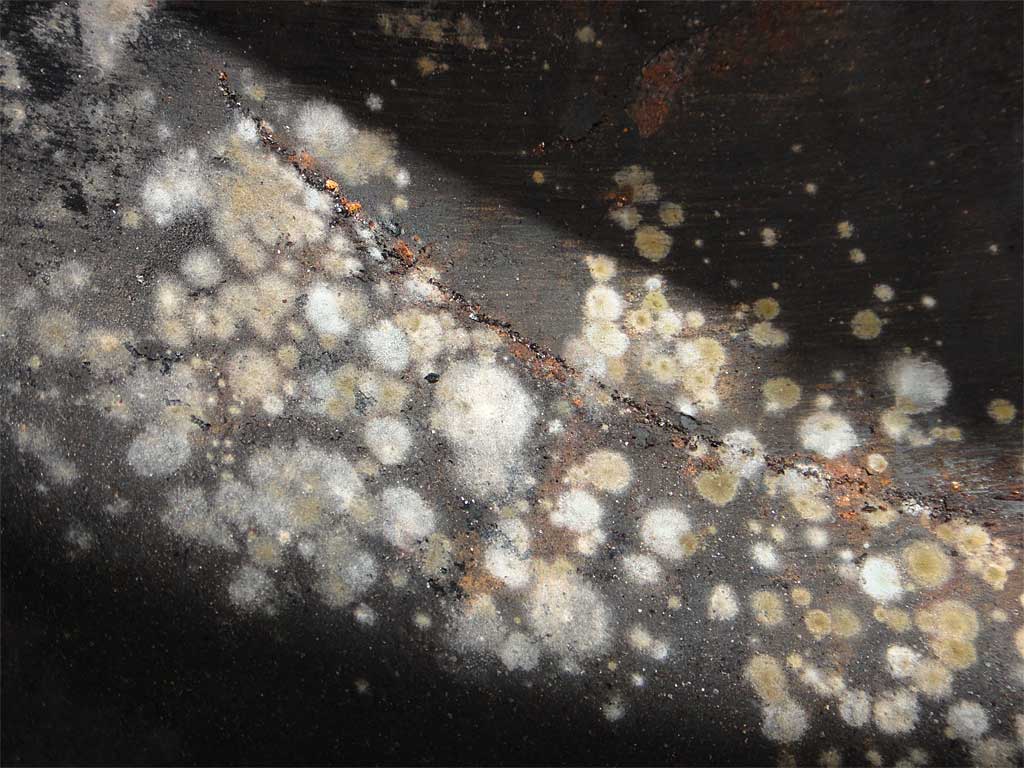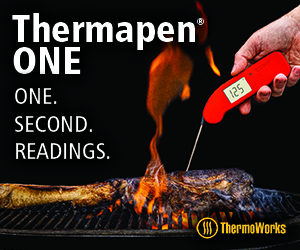In This Topic
- Cleanup Before Cooking
- Cleanup After Cooking
- Periodic Maintenance
- Clean The Exterior Of The Cooker
- Inspect The Cooking Grates For Rust
- Inspect The Charcoal Grate and Charcoal Chamber For Rust-Through
- Check For Loose Screws
- Check The Fit Of The Access Door
- Check The Access Door Knob
- Check The Lid Handle
- Check The Vent Dampers
- Check The Condition Of The Protective Vinyl Cover
- Do Not Wax The WSM
- Burning Out The Cooker
- Storing The Cooker
- Removing Grease Stains From Clothing
Proper cleaning, maintenance, and storage of your Weber Bullet will keep it operating well and looking good for many years. Just follow these tips to get the most out of your investment in Weber quality.
Cleanup Before Cooking
- Check the condition of the inside of the lid. If the seasoned surface appears smooth and/or shiny, do nothing. If it appears dry and flaky, remove the flakes with a stiff bristle brush or spray the inside of the lid with the garden hose, scrub, and rinse. You don’t want those flakes falling onto your barbecue.
- Brush any ashes or flakiness on the inside of the middle cooking section down into the bottom of the cooker.
- Make sure the water pan is clean. Accumulated grease can cause a grease fire, especially when using an empty water pan and cooking at high temperatures.
Here’s a video that shows examples of flakiness inside the lid and how to remedy it.
You’re now ready to assemble the cooker and start making barbecue!
Cleanup After Cooking
After you’ve finished cooking in your WSM, you should:
- Clean the edge of the lid & middle cooking section
- Clean the cooking grates
- Dispose of the water pan waste
- Clean the water pan
- Dispose of the ashes safely
Each of these steps is described in detail below.
Clean The Edge Of The Lid & Middle Cooking Section
While the cooker is still warm, use a paper towel to wipe off any grease from the edge of the lid and from the lip on the middle cooking section where the lid rests. This prevents the lid from becoming stuck to the middle cooking section as the grease cools.
Here’s a video that discusses how to fix and prevent sticking lids.
Clean The Cooking Grates
There are several approaches to cleaning the cooking grates:
- Wash the grates in the kitchen sink using hot, soapy water and a scrub pad, then dry thoroughly. A short 15 minute soak helps to loosen the gunk.
- Soak the grates overnight in a shallow wash tub or in a utility sink filled with soapy water, then scrub, rinse and dry.
- Spray the grates with oven cleaner or a degreaser like Dawn Power Dissolver or Greased Lightning, then scrub, rinse and dry. When using oven cleaner, place the sprayed grates in a plastic garbage bag for 30 minutes to help the spray work better and to control odor. Note that repeated use of oven cleaner will cause pitting of the grate surface. This is my preferred method for cleaning cooking grates.
- Burn off the grates over hot coals, on a gas grill, or with a propane-fired weed burner before or after a cooking session. A grill brush or a wad of crumpled aluminum foil can be used to scrub large debris from the grates. Note that burning off the grates at high temperatures will speed the breakdown of the plated finish.
Here’s a video that demonstrates how I clean WSM cooking grates using oven cleaner.
To prevent the cooking grates from rusting after washing, dry them thoroughly and store them in the garage or other dry location. Grates left in the cooker out in the weather are likely to rust over time.
To make cleaning the grates a little easier, spray them with non-stick cooking spray before use. Make sure every part of the grate is sprayed—top, bottom, edges, and handles.
Dispose Of The Water Pan Waste
Let the water pan cool enough to handle safely before removing it from the cooker. Here are two proven methods for disposing of the contents:
- Bag the fat and water with the cold ashes: Using a heavy duty trash bag, place the cold ashes in the bag then carefully pour the pan contents into the bag. The ashes will absorb the liquid. Tie the bag shut and dispose of it in the garbage. Thanks to Doug D on The Virtual Weber Bullet Board for this idea.
- Separate the fat from the liquid: Allow the fat to solidified on the surface of the water, skim it off and place it in the trash, and pour the remaining liquid down the sink. The success of this method depends on the type of fat and whether it gets cold enough to solidify.
Do not dispose of cooking fat by running it down the drain. This can clog your plumbing and your neighborhood sewer system over time.
Some folks that live in wide open spaces simply dump the pan contents somewhere on their property. This practice can attract a variety of insects and critters that you probably don’t want around.
This video demonstrates how I dispose of ashes and water pan contents after using my WSM.
Clean The Water Pan
Soak the pan in hot, soapy water to loosen gunk inside the pan and smoke residue on the outside of the pan. A non-abrasive cleanser like Soft Scrub can also be used. Scrub, rinse, and dry thoroughly.
To make cleanup of the water pan easier, cover it with heavy duty aluminum foil before use. See Using A Water Pan In Weber Smokers for details.
Dispose Of The Ashes Safely
Remove the middle cooking section and set it aside. Remove the charcoal chamber and charcoal grate and brush them off.
Ashes that seem cold on the surface may still be hot deep inside, even after sitting for two days, so take care when handling and disposing of them.
The safest way to dispose of ashes is to put them in a small galvanized metal trash can that is dedicated to the purpose of ash storage. Keep the can away from any flammable materials, including your house, wood pile, dry grass, or weeds. Let the ashes sit for a good, long time until there is absolutely no doubt they are fully extinguished, then dispose of them in your regular household garbage.
If a dedicated ash can is not an option, stir through the ashes to make sure they are absolutely cold before placing them in the garbage. I place a large yard waste bag over the charcoal bowl and dump the ashes into the bag, then brush out any remaining ash into the bag.
Using Ashes In The Garden Or Compost Pile
Ashes from lump charcoal or natural briquettes made with only wood char and starch binder may be used sparingly in the garden or compost pile with the understanding that it raises soil pH. This may or may not be to your advantage, depending upon local soil conditions. It’s best to test your soil’s pH and consult with a local university cooperative extension or master gardening program before using ashes in your garden.
Ashes from charcoal containing ingredients other than wood char and starch binder (e.g. Kingsford Original Briquets or Kingsford Match Light) should be disposed of in the trash when cold.
Reusing Leftover Charcoal
These two videos cover the topics of separating leftover charcoal from the ashes and reusing it during your next cook.
Periodic Maintenance
There are several things you can do on a periodic basis to ensure your Weber Bullet provides years of dependable service.
Clean The Exterior Of The Cooker
Wipe the outside surfaces with a damp cloth while the cooker is hot. This does a great job of “steam cleaning” the cooker, removing dirt, grime, and smoke stains. Make sure to wear heat-resistant gloves so you don’t get burned.
As an alternative, when the cooker is cold, use Windex for a light cleaning, or a degreaser like Simple Green, Purple Power, Greased Lightning or Dawn Power Dissolver—spray on, let the spray work for a few minutes, then scrub, rinse thoroughly, and dry.
For tough, baked-on grease and smoke stains, apply any of the degreasers listed above, scrub gently with 0000 super-fine steel wool, then rinse and dry.
This video demonstrates how to safely “steam clean” the outside of the Weber Bullet.
This video demonstrates how to remove tough stains from the WSM access door.
Inspect The Cooking Grates For Rust
The plated finish will break down over time with normal use, allowing rust to set in. The rust tends to start on the bottom of the grates and works its way toward the top. Cooking grates should be replaced when the rust reaches the top surface where it would come in contact with food.
The top grates can be purchased at Amazon.com (14.5″, 18.5″, 22.5″). The 14.5″ grate is the same one used in the Weber Smokey Joe portable grill, and the 18.5″ and 22.5″ grates are the same ones used in Weber charcoal kettle grills. All three can be found at home centers and barbecue stores. The bottom cooking grates can be purchased at Amazon.com (14.5″, 18.5″, 22.5″) or ordered directly from Weber at 800-446-1071. See the Parts Schematics For Weber Smokers page for part numbers.
Inspect The Charcoal Grate And Charcoal Chamber For Rust-Through
Since these parts don’t come into direct contact with food, they can go for a very long time without needing to be replaced. In fact, they may last as long as the cooker itself. If they are in particularly bad condition—for example, the grate is completely rusted and about to fall apart—you might want to consider a replacement.
To ensure you get the right charcoal grate for your cooker, these parts should be ordered directly from Weber at 800-446-1071. See the Parts Schematics For Weber Smokers page for part numbers. Please note that WSM charcoal grates are not the same as those used in Weber 18.5″ and 22.5″ charcoal grills.
Check For Loose Screws
In the cooker, not in your head! Check for loose screws that attach the legs and cooking grate flanges, tightening if necessary.
Check The Fit Of The Access Door
Bend the door gently by hand to ensure a good fit against the middle cooking section. See Parts Troubleshooting for details.
Check The Access Door Knob
Check the access door knob and tighten if necessary (2008 & earlier models). Hold the door latch with pliers and turning the knob clockwise by hand, taking care not to over tighten.
Check The Lid Handle
Check the lid handle and tighten if necessary. If the handle is cracked or missing, replacement handles can be purchased at Amazon.com or ordered directly from Weber at 800-446-1071. See the Parts Schematics For Weber Smokers page for part numbers.
Check The Vent Dampers
The lid damper can become sticky and difficult to turn with use. If so, apply Greased Lightning or white vinegar to loosen it, then rinse. If a damper on the lid or charcoal bowl is bent out of shape, see Parts Troubleshooting for instructions on how to replace it.
Check The Condition Of The Protective Vinyl Cover
Replacement covers can be purchased at Amazon.com or ordered directly from Weber at 800-446-1071. See the Parts Schematics For Weber Smokers page for part numbers.
Do Not Wax The WSM
Weber does not recommend waxing the exterior of the cooker, as this can cause streaks on the finish.
Burning Out The Cooker

If you find the inside of your WSM has been taken over by mold or insects or mice, you may want to “burn out” your cooker.
Clean out any debris inside the cooker. Light at least 2 Weber chimney starters of charcoal and pour them into the charcoal chamber, spreading them evenly over the charcoal grate. Assemble the cooker and open all the vents top and bottom. Let the cooker run as hot as possible until the fire goes out and the ashes are cold.
Brush down the interior surfaces with a stiff bristle brush and discard the ashes. Any remaining “stuff” can be cleaned out with hot, soapy water (or a very mild bleach solution), a brush and some good old-fashioned elbow grease. Rinse, let dry thoroughly, and you should be good to go.
To keep critters out, store your cooker with all vents closed. Mold needs moisture to grow, so keep your cooker covered or stored in a dry location when not in use. However, some people living in humid climates find that they need to leave vents open for air circulation to prevent mold from growing…so you may be forced to choose between critter prevention or mold prevention.
Storing The Cooker
The Weber Bullet can be stored outside all year around. Using the heavy duty vinyl cover that came with your cooker will protect it from the sun, but not rain or snow. The vinyl cover and WSM lid design are not waterproof—water will collect in the bottom of the charcoal bowl when it rains. Either store the cooker in a sheltered location or follow the tips in the Frequently Asked Questions to prevent water from entering the cooker. As mentioned earlier in this article, you may want to store the cooking grates in your garage or other dry location to prevent these parts from rusting.
Removing Grease Stains From Clothing
Finally, we have a tip from Keri C., a frequent poster on The Virtual Weber Bulletin Board, about how to remove those grease stains that inevitably get on your clothes while barbecuing.
“My briskets always try to hug me to show me how much they love me,” says Keri. “Buy a bottle of Dawn Ultra dishwashing liquid. Apply it full-strength to the grease stains on your shirt, rub it in, and then wash in warm water as usual. This has taken out every grease stain that I have managed to create so far.”






